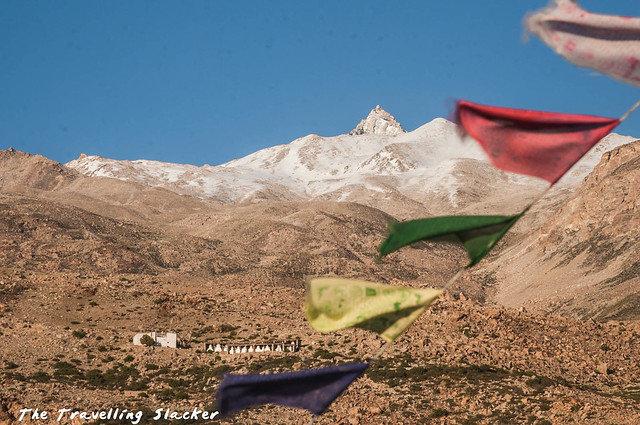As a nonreligious person, I have often surprised myself with my fondness for Buddhist myths and symbols. I am not sure why or how but I think especially the Tibetan Buddhist iconography and symbols are the most evocative, psychedelic and photogenic of them all. Those colorful flags are tailor made to flutter in the icy cold Himalayan winds and those Mani stones are destined to form epic landscapes. I have experienced this exhilaration many times before and this time at Nako it went a step further, mainly due to the literally heady combination of high altitude and the surreal moonscape.
Let me first start with the flags. As expected, they were everywhere in this Buddhist village that contain the remnants of thousand year old monastery among other things. For the best view, I climbed up the small hillock beyond the famed lake. At that point, the wind was blowing violently, thus allowing me to resume the motion blur experiment with these flags that I started last year in Chitkul. As the moon was also in the frame along with the saffron-white hillock, I believe these images came out to be less disappointing this time round.
The other most distinctive symbol of Tibetan Buddhism is of course the prayer stones or Mani stones. These are the small pebbles or stone slates with the six syllable mantra Om Mani Padme Hum sculpted all over them. This is just another way to spread the celestial blessings all over the place. While the same text is repeated everywhere, I was surprised to see how different they looked from every angle and against every backdrop. Nako is in fact full of Mani stones. There are large heaps of them at various locations of the village and not to mention the monastery. The path leading up to the hillock overlooking the village is also lined with them.
On top of these I noticed the mantra inscribed on the surface of one of peaks. I do not know how someone even got there, forget curving such immaculate letters while I have struggled with pen and paper all my life.
This of course brings me to the third element, the prayer wheels. Midsized wheels can be seen installed in every monastery. Also, the smaller ones can be carried around, spreading celestial glee all over the place. But the most noticeable one of them at Nako was the one atop the hillock, placed perfectly so that the mantras reach every corner of the village. However I do not think it is a historical construction. It is fairly new and robust. Nevertheless, the evocative sound of the metal bells on that evening while staring at the setting sun and the rising moon compensated for the lack of antiquity.
There is more to Nako than prayer flags and stones. But for the time being I must stop here. But I will be back with the rest of the stories soon.
























Jitaditya, Awesome photos
Wonderful photographs!
Amaaaazing pictures! Nako is a spectacular place, and you’ve absolutely done justice to its beauty. 🙂 And I can SO relate to and agree with the first line of this post.
Nice photos.
Pingback: Trip to the Nako Village and Lake | The Travelling Slacker
Pingback: Tabo: That Museum in the Cold Desert | The Travelling Slacker